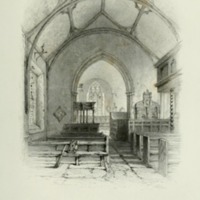Description
On his 1850s tour of Mayflower sites, William Henry Bartlett travels to Standish, Lancashire, the ancestral home of the Standish family. It is not certain whether he was a Separatist, but Miles Standish was certainly one of the most well-known of the Mayflower settlers. His reasons for travelling were likely due to the fact he was not in the line of succession from the inheritance of his family estate. Bartlett provides a rather negative description of industrial Standish alongside an account and illusion of St Wilfred’s Church:
"[T]he aspect of this district has greatly altered since the days of Myles Standish. The manufacturing system, which has since attained such stupendous development, was then in its infancy, and where tall chimneys and coal-pits vomit forth clouds of sable smoke, there was nothing but the greenness and freshness of pastoral nature. The parish of Standish abounds in these pits, which are a considerable source of wealth ; and nothing can be more dingy than the town, unless, perhaps, its still more dingy denizens, who, begrimed with the smoke and coal-dust of the pits, seem as though they had just emerged from the infernal regions. Standish Church is handsome and extensive, and bears on its battlements the shield of the family, which consists simply of three standing dishes argent, on field azure. I was disappointed at not meeting with any monuments of its more illustrious members. I glanced for a moment at a picturesque old cross and stocks in the market-place — the latter, as I was assured, not having been made use of for fourteen years. Hence I proceeded across meadows and through groves to Standish Hall, the ancient seat of this branch of the family, who are Roman Catholics; and it was here that the "Lancashire plot" of 1694 was concocted, for replacing the Stuarts on the British throne. Of the old hall, which is in the timber style peculiar to this part of England, but a mere fragment is remaining; the rest is modernised, and contains numerous family portraits of warriors in corset and buff, lawyers with peaked beards and starched ruffs, and handsome courtiers with slashed dresses and flowing lovelocks."
In 1920, the 300th anniversary of the Mayflower voyage, 'Standish Country' was a site of Pilgrim Father's commemoration.


